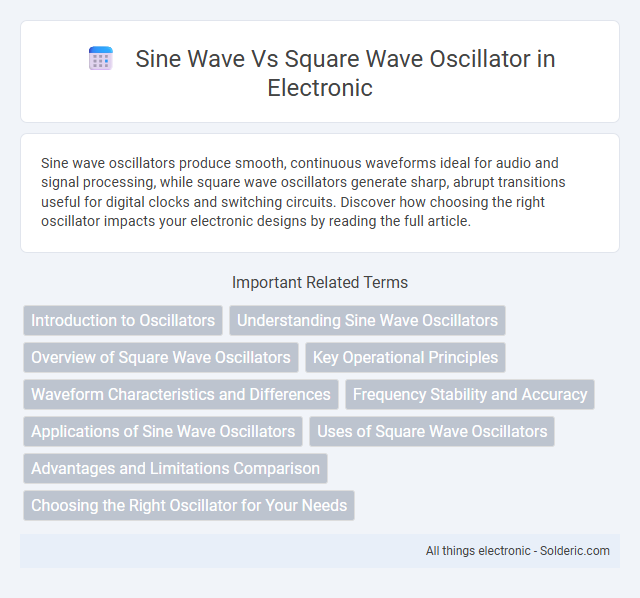Sine wave oscillators produce smooth, continuous waveforms ideal for audio and signal processing, while square wave oscillators generate sharp, abrupt transitions useful for digital clocks and switching circuits. Discover how choosing the right oscillator impacts your electronic designs by reading the full article.
Comparison Table
| Feature | Sine Wave Oscillator | Square Wave Oscillator |
|---|---|---|
| Waveform Shape | Smooth, continuous sinusoidal wave | Sharp transition between high and low states |
| Harmonic Content | Fundamental frequency with minimal harmonics | Rich in odd harmonics |
| Applications | Audio synthesis, signal modulation, test signals | Digital clocks, timing circuits, logic devices |
| Output Purity | High purity, low distortion | Contains more harmonic distortion |
| Generation Methods | LC circuits, Wien bridge, crystal oscillators | Multivibrators, microcontrollers, logic gate circuits |
| Frequency Stability | Generally high with crystal control | Moderate, depends on circuit design |
| Power Efficiency | Lower power consumption in some designs | Generally more power efficient |
Introduction to Oscillators
Oscillators are electronic circuits that generate repetitive waveforms, commonly sine waves and square waves, essential for signal processing and communication systems. Sine wave oscillators produce smooth, continuous signals with a single fundamental frequency, ideal for audio and RF applications requiring low harmonic distortion. Square wave oscillators generate signals with rapid transitions between high and low states, making them suitable for digital clock signals and logic circuits where sharp edges are necessary.
Understanding Sine Wave Oscillators
Sine wave oscillators generate smooth, continuous waveforms ideal for applications requiring low distortion and precise signal representation, such as audio synthesis and communication systems. These oscillators rely on components like RC or LC circuits to maintain consistent frequency and amplitude, ensuring signal purity. You benefit from sine wave oscillators in scenarios demanding minimal harmonic content and stable oscillation.
Overview of Square Wave Oscillators
Square wave oscillators generate a waveform characterized by abrupt transitions between high and low voltage levels, producing a distinctive rectangular output. Common implementations include 555 timer circuits and digital flip-flop oscillators, widely used for clock signals, pulse generation, and switching applications. Their harmonic-rich spectra contrast with sine wave oscillators, which provide smooth, single-frequency outputs ideal for audio and RF synthesis.
Key Operational Principles
Sine wave oscillators generate smooth, periodic signals by amplifying and filtering feedback to maintain a pure sinusoidal output, ideal for audio and RF applications requiring minimal harmonic distortion. Square wave oscillators rapidly switch output levels between high and low states, creating a signal rich in harmonics and suitable for digital clocks and pulse circuits. Understanding these key operational principles helps you select the right oscillator type based on the waveform purity and application needs.
Waveform Characteristics and Differences
Sine wave oscillators produce smooth, continuous waveforms characterized by a single fundamental frequency with minimal harmonic distortion, resulting in pure sound or signal output. Square wave oscillators generate waveforms that abruptly switch between high and low states, containing a fundamental frequency plus a rich series of odd harmonics, which creates a buzzy, hollow tone. Your choice depends on whether you need a clean, tonal signal from a sine wave or a harsher, more complex waveform from a square wave for your application.
Frequency Stability and Accuracy
Sine wave oscillators offer superior frequency stability and accuracy due to their smooth waveform and lower harmonic distortion, making them ideal for precise signal generation in communication and audio applications. Square wave oscillators, while easier to generate and useful for digital circuits, tend to exhibit more jitter and frequency deviations because of their sharp transitions and higher harmonics. Your choice depends on the requirement for signal purity versus simplicity and cost in oscillator design.
Applications of Sine Wave Oscillators
Sine wave oscillators are essential in generating pure tone signals for audio equipment, function generators, and RF communication systems where low distortion and harmonic purity are critical. These oscillators are widely used in medical devices like ultrasound machines, test instruments, and signal processing circuits requiring stable and clean sinusoidal signals. You benefit from their ability to produce smooth waveforms, ensuring accurate measurements and reliable performance across various scientific and industrial applications.
Uses of Square Wave Oscillators
Square wave oscillators generate signals with rapid transitions between high and low levels, making them ideal for digital circuits and clock generation. They are extensively used in microcontrollers, digital signal processing, and timing applications where precise, stable pulses are essential. Your electronic projects benefit from square wave oscillators in tasks such as switching power supplies, pulse width modulation (PWM), and frequency synthesis.
Advantages and Limitations Comparison
Sine wave oscillators produce smooth, pure tones ideal for audio applications and signal processing due to minimal harmonic distortion, while square wave oscillators generate signals with sharp transitions, advantageous for digital circuits and clock signals but prone to producing significant harmonic content. You may find sine wave oscillators preferred when signal purity and low noise are critical, whereas square wave oscillators offer simplicity and ease of generation, often at the cost of increased electromagnetic interference. The choice between sine and square wave oscillators depends on balancing the need for waveform accuracy against the simplicity and robustness suited for timing and switching applications.
Choosing the Right Oscillator for Your Needs
Selecting between a sine wave oscillator and a square wave oscillator depends on the specific application requirements. Sine wave oscillators produce smooth, pure tones ideal for audio synthesis and communication systems that demand minimal harmonic distortion. Square wave oscillators generate rich harmonics suited for digital clocks and switching circuits, making your choice crucial for optimizing signal quality and system performance.
sine wave vs square wave oscillator Infographic

 solderic.com
solderic.com